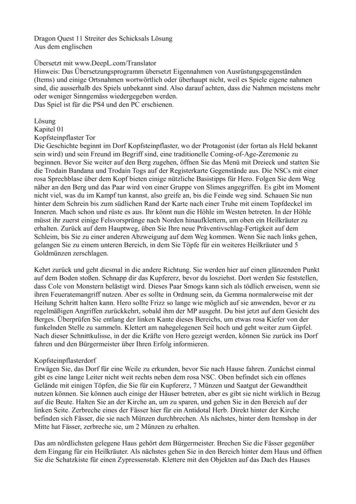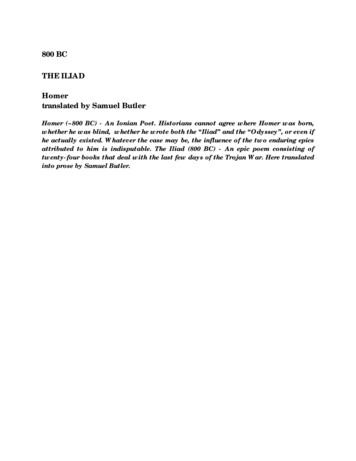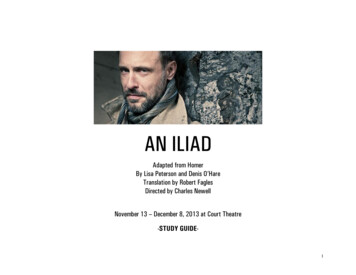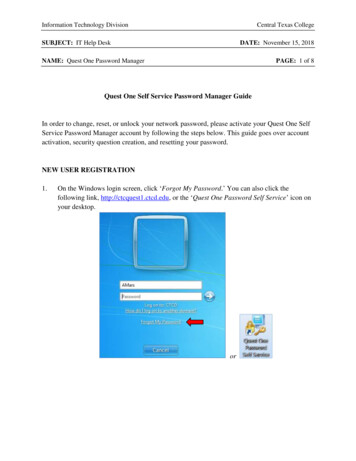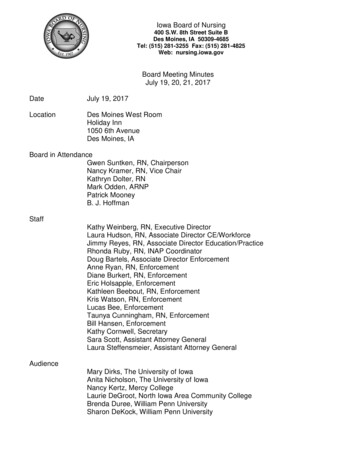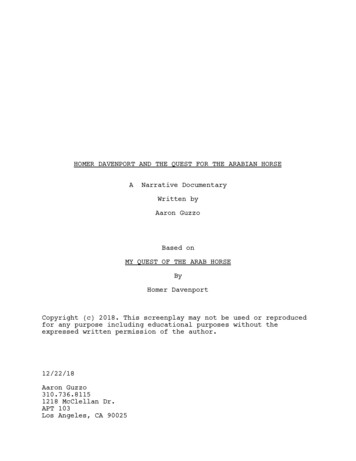
Transcription
HOMER DAVENPORT AND THE QUEST FOR THE ARABIAN HORSEANarrative DocumentaryWritten byAaron GuzzoBased onMY QUEST OF THE ARAB HORSEByHomer DavenportCopyright (c) 2018. This screenplay may not be used or reproducedfor any purpose including educational purposes without theexpressed written permission of the author.12/22/18Aaron Guzzo310.736.81151218 McClellan Dr.APT 103Los Angeles, CA 90025
NOTE: You will notice the photos listed throughout the scripthave a number after them. Some have a p before them (pxx),while some have a # before them (#xx). The photos with the(pxx) notation are referring to the location of said imagesin THE ANNOTATED QUEST - HOMER DAVENPORT & HIS WONDERFULARABIAN HORSES (Seauphah Publishing Assoc. Inc., Copyright1992, ISBN 0-9634581-0-8). The photos with the (#xx) notationare referring to a DropBox folder containing thecorresponding photos, all numbered accordingly for yourreference. Contact Paul Husband for access to the Dropboxfolder.NOTE: This is a “documentary screenplay” (for lack of abetter term), and it alternates between historical photos,stock footage, original live re-enactments, historicalsketches by Davenport, and yet to be created drawings /paintings. All of these visuals are merely suggestions andreferences which can be changed if needed to best servebudget, resources, time, and the story itself. The main focushere is the narration and story.FINAL NOTE: If funding is not available to portray the liveaction scenes, these can be done as a “radio drama,” withvoice actors performing the lines with sound effects and afew paintings / sketches appearing throughout as a visual- Aaron Guzzo
2.INT. DINGY BAR - CONSTANTINOPLE - NIGHTThree men sit at a dimly-lit table across from a grey-hairedman in a white suit. The four of them are the only whitepeople in this noisy bar. Vague Middle-Eastern music fillsthe background as well a host of Turks and Middle-Easterners.TEXT: CONSTANTINOPLE (ISTANBUL) - July 1906The man in the suit, WILLIAM FORBES (70s), leans in.FORBESThey call him “The Pride of theDesert.” He was a gift to theGovernor of Aleppo from the Bedouinpeople. I’ve offered fortunes tohave him, enough to fill tenpalaces. but the Governor won’tbudge. And I’m not the only oneafter him - the Italian Governmentoffered more than I did. and theygot nowhere. You see, he’s theperfect specimen, the most soughtafter prize in all of the Arabiandesert. So forgive me for having mydoubts that the three of you willget anywhere.The three men he’s speaking to are HOMER DAVENPORT (39),balding and sporting a thick moustache, ARTHUR MOORE, 6’4”,245 lbs, and JACK THOMPSON, “a tall athletic man with thesnappiest eyes.” They look out of place here. Davenportpoints to a piece of paper on the table.DAVENPORTSurely he isn’t the only one outthere, is he? I bet we could findat least eight others.FORBESOh, finding them will be easy. Butthey’re fiercely protected by theBedouins, and the Bedouins they’ll swear to anything but thetruth. And even if you do convincethem to do business with you andyou get what you came for, gettingyour prize back to America will beeven harder.MOOREWe’ve made several preparations-
3.FORBESBoy, I don’t think you heard me.Let me put this bluntly: Do NOT gointo the desert right now. Thereasons are endless but I’ll giveyou four: One - it’s July. You’lldie of a heat stroke before youeven reach Aleppo. Two - theBedouins are at war. They’re alwaysat war, but right now thefighting’s so bad my company’s hadto stop shipping liquorice from theentire region. If you don’t haveprotection from a local, you’ll beunsafe. Three - once you’re in thedesert how do you plan to get anyinformation?Davenport produces a book titled Bedouin Tribes of theEuphrates.DAVENPORTWe have a reference book.FORBESAnd when was it written?DAVENPORT.Thirty years ago.FORBESThen nearly nothing in it will beaccurate. The Bedouins’ alliances,locations, and customs change withthe seasons. You may as well throwit away.DAVENPORTBut I like it.FORBESAnd lastly, and most seriously:(points to a map on thetable)I see your journey’s next stop isAlexandretta.DAVENPORTYes. We begin our journey to thedesert from there.
4.FORBESAvoid Alexandretta at all costs.You’ll find nothing there butpoverty, thieves, and Turkishspies. And on top of that, themosquitoes of Alexandretta are themost deadly species of anymosquitoes in the Ottoman Empire.It is, without question, the mostunhealthy place in the world. Doyou all understand?They all nod.We do.DAVENPORTEXT. SHIP - PORT OF ALEXANDRETTA - DAYDavenport, Thompson, and Moore stand on a ship entering aport. They pass under a sign written in Arabic. A captiontranslates: PORT OF ALEXANDRETTA.Davenport bursts with excitement.DAVENPORTBy God, we’re doing it. I’ve waitedmy whole life for this.THOMPSONTo risk your life buying somehorses?DAVENPORTThat’s what you think this is allabout? Horses?THOMPSONIt’s why we’re here, isn’t it?DAVENPORTWe didn’t come all this way forhorses, my dear boy. We came allthis way for Arabian horses.THOMPSONIsn’t that still -
5.DAVENPORTThere has been but one thoughtuppermost in my mind ever since mychildhood, and that is to go to thedesert, find Arab mares ofunquestionable blood, and bringthem to America. And if I die inthe process, I’ll die happy.Beat.Horses.THOMPSONDAVENPORTBefore you judge me, you would needto know me.TITLE CARD: DAVENPORT IN ALEPPO: MY QUEST OF THE ARAB HORSETEXT: PART ONE - Homer Davenport - The Early YearsPHOTO: Young Homer Davenport and his mother (#1)NARRATOR (V.O.)Homer Davenport was born outside ofSilverton, Oregon, on March 8, 1867to FLORINDA WILLARD DAVENPORT &TIMOTHY WOODBRIDGE.PHOTO: Timothy Woodbridge (#2)NARRATOR (V.O.)They were a progressive family Homer's grandfather, Benjamin, wasan abolitionist whose Ohio home wasa stop on the Underground Railroad.When Florinda and Timothy weremarried in 1854, Timothy tookFlorinda's last name. Before Homerwas born, they had two otherchildren who were lost todiphtheria, as there was anoutbreak on the west coast in 1856.PHOTO: Young Homer Davenport and his mother (#1)NARRATOR (V.O.)While pregnant with Homer, Florindahad a prophecy of her son becominga cartoonist - a prophecy whichwould come true in full force yearslater.
6.PHOTO: Russell Trall (#3)NARRATOR (V.O.)She also followed the instructionsof an essay by Russell Trall called"How to Born A Genius." Though theinstructions of the essay, whichincluded diet recommendations and"concentration" exercises, may havenot been scientifically sound, theynonetheless yielded the results shewanted PHOTO: Any of Davenport’s cartoonsNARRATOR (V.O.)Homer Davenport would become thehighest-paid cartoonist in thecountry as an adult. Florinda,however, would not see thissuccess, as she died of smallpoxwhen Homer was just three yearsold.SCAN: Drawing / painting (NOT a Davenport) of Florinda on herdeathbed clutching TimothyNARRATOR (V.O.)On her deathbed, she instructedTimothy to give Homer everyopportunity to become a cartoonist.Timothy faithfully followed theseinstructions.EXT. TIMOTHY WOODBRIDGE’S HOME - NIGHTThrough the billowing snow we see a sinister red X painted onthe front door of the Davenport / Woodbridge home. A passingfamily crosses to the other side of the street upon seeingit.NARRATOR (V.O.)Due to the very smallpox outbreakwhich killed Homer's mother, he andhis father were quarantined insidetheir home the winter of 1870-1871.INT. TIMOTHY WOODBRIDGE’S HOMEYOUNG HOMER DAVENPORT (3) unwraps a box of paints in front ofa fireplace. Timothy watches his reaction apprehensively.
7.NARRATOR (V.O.)During that time, Timothy gaveyoung Homer a box of paints as aChristmas gift.LATER - Timothy reads to Little Homer from a book. Homerlistens with wide-eyed awe.NARRATOR (V.O.)He also told him stories of Arabianhorses to pass the time - storieswhich took the boy's imagination bystorm.SFX: Clip-clop of horses galloping, horses whinnying, shoutsof the jockeys, bugles playing. We HEAR what Homer is seeing.SCAN: Davenport’s lumpy childhood horse sketch (#4)NARRATOR (V.O.)The first images he created withthe paints were of Arabian horses.Due to scarce information on whatArabian horses actually lookedlike, Homer's first depictions ofArabian horses were less thanaccurate (as he believed thatArabian horses had spots).IMAGE: One of Davenport’s later professional horse sketchesNARRATOR (V.O.)This would change in later years,though - Homer would develop anuncanny ability to draw horses - oranything - from memory.MAP: Silverton, Oregon, 1878 (#4.5)NARRATOR (V.O.)When his father remarried in 1872,he moved the family to Silverton,Oregon's Latin Quarter, so thatHomer,PHOTO: Young Davenport (#5)NARRATOR (V.O.)Now age 5, may "inhale any artisticatmosphere" there.PHOTO: Main Street, Silverton, Oregon (p3)
8.NARRATOR (V.O.)It was here that young Homer’spropensity for drawing earned him areputation.EXT. SILVERTON, OREGON - DAYYOUNG HOMER DAVENPORT (5) sits on the curb, sketching thestreet scene. An OLD MAN approaches him.OLD MANWhy aren’t you in school?YOUNG DAVENPORTIt’s summer.OLD MANWhat are you doing out here all byyourself?YOUNG DAVENPORTI’m drawing.OLD MANShouldn’t you be helping your dadat the store?YOUNG DAVENPORTI’m drawing.OLD MANA boy ought to be learning how towork.YOUNG DAVENPORTDrawing is work.Beat.OLD MANYou know what the word “shiftless”means?VIDEO: Stock footage of a circusNARRATOR (V.O.)In his teenage years, the circuscame to Silverton, and with thecircus came horses.(MORE)
9.NARRATOR (V.O.) (CONT'D)Homer's obsession had not abated,and he left with the circus, sothat he may be near the horses,which he sketched constantly.However, circus life was not forhim.INT. CIRCUS TENT - NIGHTTeenage Homer Davenport sits by an elephant, sketching it.His BOSS approaches him with a large brush and a bucket.BOSSBrush this entire elephant downwith linseed oil.No.TEENAGE DAVENPORTBOSSYou’re fired.SCAN: Drawing / painting (not a Davenport) of a lineup ofjockeys. Pan down the line until we reach TEENAGE DAVENPORT,who towers above the rest, his head out of frame.NARRATOR (V.O.)He then tried being a jockey another job that allowed him to benear horses - but he was far tootall. He tried his hand at being astore clerk, a railway fireman, anda stoker on a steamboat, but hisreal passion remained horses, anddrawing.PHOTO: The Mark Hopkins School of Art (a mansion) - (#6)NARRATOR (V.O.)In 1889, Davenport attended theMark Hopkins School of Art in SanFrancisco, California, but he wasalmost immediately expelled becauseof his preference to draw cartoonsinstead of his assignments.PHOTO: Portland Telegram Building (#7)NARRATOR (V.O.)He did, however, find some moderatesuccess at the Portland EveningTelegram, which published severalof his drawings. but for no pay.
10.PHOTO: Young man Davenport (#8)NARRATOR (V.O.)He briefly attended ArmstrongBusiness College in 1890 butquickly dropped out. It seems that,to 24-year-old Homer Davenport, ifit didn't involve horses orcartooning, it wasn't for him.DAVENPORT (V.O.)During this time I missed Oregon.It got so bad I had to ask myrelatives to not send me anythingthat reminded me of Silverton, asit would send me into despair andmelancholia. I missed home.INT. OREGONIAN OFFICE - DAYDavenport (mid-20s) stands before a few MIDDLE-AGED BOSSESwith a cloth over an easel, about to present something.NARRATOR (V.O.)It wasn't all doom and gloom forDavenport. He secured his firstpaying job as an artist for theOregonian. However, his streak ofshort-term employment was far fromover:Davenport unveils the drawing: A comically bad, childishstick-figure depiction of a stove. The bosses erupt intoanger, shouting and throwing things at him. He leaves in ahurry. NOTE: This scene is a tongue-in-cheek dramatization.NARRATOR (V.O.)After he could not draw a stoveproperly for an advertisement. hewas fired. His talent lie indrawing people and animals. Thoughhis first paying job as an artistwas a failure, as was so much elsethat he tried, his next job wouldserve him well.EXT. SMALL-TOWN STREET - DAYYoung Davenport (20s) sits on a curb surrounded by a group ofyoung boys. A policeman glowers at them from across thestreet.
11.Davenport makes a comical sketch of him to the delight of theboys, who laugh wildly at it. and pool together some moneyfor the drawing.NARRATOR (V.O.)In 1891 he worked for the PortlandSunday Mercury, where he traveledto New Orleans to sketch a boxingmatch. Along the way he made extramoney selling his drawings aspostcards.A shadow falls over them - a man stands over them,silhouetted.NARRATOR (V.O.)This talent caught the eye of C.W.Smith, who also just so happened tobe his father's cousin. Smith wrotea letter to the business manager ofThe San Francisco Examinerdemanding that he be hired.INT. EXAMINER LOBBY - DAYYoung Davenport (20s) waits for his interview. While waiting,he doodles a caricature of the grumpy-looking secretary. AHAND clamps down on Davenport’s shoulder - the BOSS!BOSSWhat is this?He looks at the doodles.BOSS (CONT'D)This drawing is rude! It’spreposterous! You’re hired!FREEZE FRAMENARRATOR (V.O.)However, yet again, Davenport'ssuccess would be short-lived. Whenhe demanded a raise from his salaryof 10 a week a year later. hewas fired.SCAN: Davenport’s portrait of himself when he was a young man(#9)
12.NARRATOR (V.O.)But talent is talent, and he had noshortage of admirers at this point,which led him to a job at the rivalSan Francisco Chronicle 1892.During his time there, his fan basegrew even more. But something wason the horizon that would changehim - and America - forever:PHOTO: The Grand Basin of the Columbian Exposition (#10)NARRATOR (V.O.)The 1893 World's ColumbianExposition in Chicago, Illinois.where, in addition to every otherimaginable oddity on earth, therewould be Arabian horses. Davenportused his contacts to secure a jobat the Chicago Herald which wouldpay him to sketch the horse racesat Washington Park SCAN: Davenport’s drawing for the Chicago Herald (p4)NARRATOR (V.O.)Photographic reproduction was stillin its infancy, and hiring someonelike Davenport to just sketch themwas the more economical option.GRAPHIC: A stock image of a woman from the 1890s. with aquestion mark graphic obscuring her face.NARRATOR (V.O.)While in Chicago, he married DAISYMOORE, of which very little isknown, as she is not even mentionedin his memoir. She left her home inSan Francisco to join him inChicago.PHOTO: Hamidie Society performers at the Chicago World’s Fair(p8)NARRATOR (V.O.)While at the Chicago Herald,instead of going to the horse trackto sketch the races as instructed,he went to the World's Fair tosketch the Arabian horses ondisplay there. At this point, youmay be able to guess what happenednext:
13.INT. CHICAGO HERALD OFFICE - DAYA GRUMPY BOSS with orange hair sits at his desk. Davenportstands before him.GRUMPY BOSSYou’re fired.INT. HOTEL ROOM - DAYDAISY sits with her head in her hands. Davenport (30s - willbe played by the same actor from here on out) tries tocomfort her.DAVENPORTBut don’t you see? It was all worthit! My entire life revolves aroundArabian horses, and I finally gotto see them!She is not consoled in the slightest. Davenport gets down onhis knees and takes her hands into his.DAVENPORT (CONT'D)And there’s something else, too,Daisy - tomorrow could very well bethe biggest day of my life: I willmeet Bedouins from the Arabiandesert for the first time. I hopeit goes well!PHOTO - Another photo of the Bedouins exhibit at the ColumbiaExposition (#11)NARRATOR (V.O.)It did not, despite his having thebest of intentions.The photo MORPHS into a LIVE-ACTION SCENE.EXT. BEDOUIN HORSE GROUNDS, COLUMBIAN EXPOSITION - DAYBedouins show off their majestic Arabian horses, who trotabout in SLOW-MOTION, showing them in their full glory - weshould see them as Davenport sees them. Davenport sits to theside, sketching away, his eyes alight. His sketch complete,he timidly approaches the Bedouins.DAVENPORTAhoy! My name is Homer. I have agift for you.
14.He presents his drawing, folded in half, to the solemn-facedold men. They take it, unfold it. and burst into a fit ofrage. They drop the drawing and all produce SWORDS. Davenportstumbles back. The men then tear the drawing to pieces andstomp it.FREEZE FRAMENARRATOR (V.O.)The snafu here was that he depictedthe horses with their tails down,which is a great insult in Bedouinculture. It would be over a decadebefore he would see anotherBedouin.ANIMATION - We’re looking at a map, focused on Chicago andsurrounding area. As the narrator talks, we move across theworld, to the East, landing in the Syrian desert, on a tinydot labeled Manbij.NARRATOR (V.O.)The Bedouins in question were frommodern-day Syria, 6,000 miles away,STOCK FOOTAGE of Arabian horses in their gloryNARRATOR (V.O.)For 5,000 years they havedomesticated and bred Arabianhorses, carefully selecting onlythe strongest and best-tempered toreproduce. They kept immaculaterecords of the bloodlines, which isgenerally traced through thematernal line. The result has ledto Arabians being the purest, mostsought-after, and most recognizablebreed in the world, capturing theimaginations of horse aficionadosthe world over, like HomerDavenport.INT. DAVENPORT'S HOME - KITCHEN - DAYDaisy makes dinner, bored out of her mind from Homer’sdroning:DAVENPORT-And they’re the foundation ofseveral other breeds. They dominatenearly every equestrian field, fromendurance riding to horse racing.
15.INT. CHICAGO HERALD OFFICE - DAYThe orange-haired boss’s eyes are glazed over as Davenportspeaks.DAVENPORTYou know why Arabian horses arenicknamed "Drinkers of the Wind?"GRUMPY BOSSBecause they’re fast?DAVENPORTBecause they’re fast.SCAN: Painting (not Davenport) of Genghis Khan on his horse(#11.5)DAVENPORT (V.O.)Genghis Khan,SCAN: Painting (not Davenport) of Napoleon on his horse(#11.6)Napoleon,DAVENPORT (V.O.)SCAN: Painting (not Davenport) of Alexander the Great on hishorse (#11.7)DAVENPORT (V.O.)-and Alexander the Great allcarried out their conquests fromthe backs of Arabian Horses.EXT. BEDOUIN HORSE GROUNDS, COLUMBIAN EXPOSITION - DAYDavenport brushes an Arabian horse.DAVENPORT(to us)In addition to their impressivefeatures and accomplishments,Arabians are incredibly welltempered.STOCK FOOTAGE (or get our own footage) of BedouinsNARRATOR (V.O.)The tribe Davenport would be goingto do business with, the FedaanAnezeh tribe, did not share theirhorses’ good temper.(MORE)
16.NARRATOR (V.O.) (CONT'D)According to Davenport, they werethe most warlike and uncivilizedBedouins in the world.MAP of their territory.NARRATOR (V.O.)They were also the most powerful.They have a mysterious history thatpredates Islam. The Encyclopedia ofIslam simply says, “It is not knownwhence they came,” but it isbelieved they came from the Iraqidesert near Karbala. Their enemieswere the mighty Shammar tribe tothe East, across the Euphrates.FOOTAGE from Lawrence of Arabia, if possible.NARRATOR (V.O.)Ten years after Davenport’s visit,they would be among the tribes whotook part in the Arab Revoltagainst the Ottoman Empire,famously depicted in Lawrence ofArabia.STOCK FOOTAGE (or get our own footage) of BedouinsNARRATOR (V.O.)Regarding the Bedouin war men,Davenport writes that they hadDAVENPORT (V.O.)No purpose in life other than tosit around til some raid started,NARRATOR (V.O.)However he conceded:DAVENPORT (V.O.)The true Bedouin is a gentleman.His hospitality is unsurpassed, andeven if he hates you he has theknack of making his hospitalityappear entirely genuine. You may behis personal enemy, as well as histribal enemy, still, if you cameand touched his tent rope, he isbound to protect you; you are hisguest. To offer a tip would be aninsult to the poorest Bedouin.
17.STOCK FOOTAGE (or get our own footage) of Bedouin womenNARRATOR (V.O.)Regarding the Anezeh women,Davenport describes them as beinglittle more than slaves. They wereseldom seen, confined to theirtents cooking, cleaning, andraising their children. Meanwhile,the men, who could have up to fourwives,DAVENPORT (V.O.)stroll here and there as if theybelong to some great club, which ina way they do.PHOTO: Achmet Haffez (p80)NARRATOR (V.O.)The Diplomatic Ruler of the AnezehBedouins was a man named AchmetHaffez. Little is known about himoutside of Davenport’s writing. Inorder to complete his mission anddream of bringing Arabian horses toAmerica, Davenport would have toearn this man’s trust.TEXT: PART TWO - Political Cartoon CareerPHOTO: Homer Davenport sketching at his easel (#12)NARRATOR (V.O.)Back in America, Davenport's streamof short-lived employment wouldfinally come to an end. After beinglet go from the Herald, Davenportwent back to the San FranciscoExaminer, which was owned byWilliam Randolph Hearst.PHOTO: William Randolph Hearst (#13)NARRATOR (V.O.)This time, Davenport's "cartooning"was not only encouraged; it was hisjob. And not only was it his job;it was his true calling.RAPID-FIRE MONTAGE: A few quick shots of various Davenportcartoons
18.NARRATOR (V.O.)He lampooned the various candidatesof California's 1894 elections togreat effect. Hearst himselffollowed his work and was a fan.PHOTO: The previous photo of Hearst morphs into Davenport’scaricature of him (ANNOTATED CARTOONS, p85)NARRATOR (V.O.)When a famous horse died which hadnever had its picture taken,Davenport sketched it from memory,having only seen it once a yearbefore - a feat which impressedHearst, who bought the drawing andtransferred Davenport to New YorkCity.FOOTAGE from Citizen Kane if possible. If not, then:SCAN: front page of the New York Journal (any edition)NARRATOR (V.O.)There, he began work at the newlyformed New York Journal, which hadone of the greatest staffs innewspaper history, with suchcontributors asPHOTO: Mark Twain (#14)NARRATOR (V.O.)Mark Twain giving it notoriety. Forthe first time ever, Davenport hada high salary.PHOTO: William McKinley / William Jennings Bryan (#15 & 16)NARRATOR (V.O.)When you're a political cartoonist,presidential elections are yourbread and butter, and the 1896election between Republican nomineeWilliam McKinley and Democraticnominee William Jennings Bryan wasno exception. The New York Journalwas a Democratic newspaper, soDavenport was sent to Washington tofind character flaws in Republicannominee William McKinley to exposeand mock in his cartoons.
19.INT. CROWD - DAYDavenport watches WILLIAM McKINLEY (53) from afar. McKinleyshakes hands, smiles, and is generally likable. HEARST (33)approaches Davenport.HEARSTSo, how is my favorite cartoonistdoing? Have you roasted him on aspit yet?DAVENPORTNo. He’s scandal-free. His publicimage is impeccable. He’s likable.Hell, I like him. It’s a nightmare.I’ve got nothing.Davenport CRUMPLES UP his sketch. Then.Another man, MARK HANNA (59) appears over McKinley’sshoulder, whispering in his ear and managing his every move,directing him here and there. McKinley obediently follows hisevery command.DAVENPORT (CONT'D)Hold, hold - who is that?HEARSTThat’s Mark Hanna. He’s McKinley'spolitical manager. Industrialistfrom Cleveland. Practically made ofmoney. He’s raised 3.5 milliondollars for Mckinley’s campaign DAVENPORT 3.5 MILLION DOLLARS?!!HEARSTThe most expensive campaign in UShistory. He’s also paid off all ofMcKinley’s debts, and DAVENPORTHe’s holding that over McKinley'shead.A smile forms on Davenport’s face. He begins to sketch withrenewed purpose.SCAN: Davenport’s “A Democratic Rise in the Ohio” (TheAnnotated Cartoons, p55)
20.NARRATOR (V.O.)McKinley was a bought man, as wasthe Republican Party, and the manwho bought them both was MarkHanna.SCAN: Davenport’s “Mr. Hanna’s Stand on the Labor Question”(The Annotated Cartoons, p57)NARRATOR (V.O.)The cartoons that followed werescathing, brutal depictions ofHanna. Subtlety was not the name ofthis game.SCAN: Davenport’s “Wall Street’s New Guardian” (The AnnotatedCartoons, p 59)NARRATOR (V.O.)Davenport’s message was clear: Avote for McKinley was not in fact avote for McKinley but for Hanna andhis financial interests - a conceptwhich at the time would have beenmore shocking than it is today.EXT. FARM HOUSE - DAYA FARMER and his WIFE stand in front of a farm house,American Gothic-style.FARMERNonsense! Rich people influencingelections? That never happens!INT. OFFICE - DAYHANNA and McKINLEY look at one of the cartoons printed in thenewspaper. Hanna looks troubled.NARRATOR (V.O.)Upon seeing the cartoons, Hannasupposedly saidHANNAThat hurts.NARRATOR (V.O.)-But McKinley was amused by themand kept a file of his favoriteDavenport comics.
21.On McKinley, who grins and begins to cut the comic out.MCKINLEYMudslinging is part of the game, myfriend.SCAN: Davenport’s “I Am Confident The Working Men Are Withus.” (The Annotated Cartoons p67)NARRATOR (V.O.)They affected more than just thecandidates' moods - they affectedthe entire country. Nothing inpaper came close to matching theirimpact.SCAN: Davenport’s “A Man of Mark” - the Watch-fob version(The Annotated Cartoons p68)NARRATOR (V.O.)Davenport's cartoons ran a fewtimes per week and were widelyreprinted. Despite his impact,William Jennings Bryan was unableto overcome the public's mistrustof Democrats,SCAN: The Panic of 1893, crowds in chaos (#17)NARRATOR (V.O.)-who were blamed for the 1893Financial Panic from which thecountry was still recovering. AfterMcKinley's victory, Davenport andHanna met. All was in good humor.Hanna is reported to have said:INT. OFFICE - DAYDavenport and Hanna aggressively shake hands.HANNAI admire your genius and execution,but damn your conception.INT. DIFFERENT OFFICE - DAYDavenport and Hanna shake hands in a different office.
22.NARRATOR (V.O.)When Hanna was elected to the OhioSenate in 1898, Davenport wishedhim well, saying:DAVENPORTThat insures me six more years atyou, and you’re a good subject.INT. AIR TUNNELDavenport stands proudly amid a flurry of cash, which fliesaround him.NARRATOR (V.O.)The 1896 Election launchedDavenport to stardom and wealth. Hewas paid 12,000 per year (equal toover 350,000 in 2018) - making himthe highest- paid cartoonist of histime. In addition, Hearst, despitelosing a fortune that year, gavehim a 3,000 bonus to be used totake his wife to Europe.INT. HEARST’S OFFICE - DAYVarious newspaper executives stand and applaud for Davenportas he and Hearst shake hands.HEARST(sotto)So what will you do with all thismoney I’m throwing at you?Davenport is fixated on a huge painting of an Arabian horsehanging from the wall.DAVENPORTOh, I’ve got something planned.Something big.PHOTO: Thomas C. Platt (#18)NARRATOR (V.O.)Davenport's greatest politicalachievement may have been whenRepublican Senator Thomas C. Plattand others introduced an anticartoon bill in the statelegislature to ban politicalcartoons from New York.(MORE)
23.NARRATOR (V.O.) (CONT'D)It did not pass, and it inspiredone of Davenport's most famousworks:SCAN: Davenport’s “No Honest Man Need Fear Cartoons” (TheAnnotated Cartoons p173)NARRATOR (V.O.)"No Honest Man Need Fear Cartoons."There was now no doubtingDavenport's influence. His salarygrew to 25,000 a year - over 600,000 in 2018.SCAN: Drawing of McKinley’s assassination (#19)NARRATOR (V.O.)Unfortunately, it was not cartoonsthat William McKinley needed fear,but anarchist Leon Czolgosz, whowatched him speak at the PanAmerican Exposition in Buffalo, NewYork. At 4:07 PM, September 6,1901, Czolgosz shot McKinley in theabdomen.FOOTAGE from McKinley’s funeral processionNARRATOR (V.O.)McKinley was a gentleman to theend, telling the angry crowd to goeasy on Czolgosz. He seemed torecover from his wounds, but at2:15 AM on September 14th, the 25thPresident of the United Statesdied, making him the third of fourPresidents to die by assassination.IMAGE: Teddy Roosevelt (#24) - or otherNARRATOR (V.O.)Theodore Roosevelt was sworn inthat very day, making him the 26thPresident of the United States.and thus the subject of HomerDavenport's cartoons.SCAN: Davenport’s “The Frightened Animals See Who’s Coming”(#20)
24.NARRATOR (V.O.)Though he did lampoon him for hispropensity for big game hunting, itwas hard for Davenport to dislikehim.PHOTO: Roosevelt on a horse (p12)NARRATOR (V.O.)After all, Roosevelt was a fellowhorseman who had become an Americanhero in the Spanish-American War,when he lead the Rough Riders tovictory on horseback.SCAN: Drawing of The Evening Mail’s offices (#21)NARRATOR (V.O.)So when the New York Evening Mailoffered to repay Davenport’s 25,000 salary for the last sixmonths of 1904 and then anundisclosed (but presumablygreater) amount after that toswitch from blue to red, he eagerlyaccepted and drew his magnum opus:SCAN: Davenport’s “He’s Good Enough For Me” (#22)NARRATOR (V.O.)"He's Good Enough for Me," whichbecame the face of Roosevelt's 1904campaignSCAN: The famous 2008 Yes We Can PosterNARRATOR (V.O.)- not unlike Obama's "Yes We Can"poster, and it did the trick SCAN: November 9, 1904 Washington Tribune - “Roosevelt WinsBy Landslide” (#23)NARRATOR (V.O.)Roosevelt won in a landslide, andwas forever grateful forDavenport's undeniable contributionto his campaign. Davenport hadsecured an ally in the President ofthe United States.PHOTO: Roosevelt on a horse (p12)
25.NARRATOR (V.O.)This, coupled with their sharedinterest in all things equestrian,paved the way for Davenport tobegin preparations for the journeythat his life's work had lead himto:PHOTO: The cover of “My Quest of the Arab Horse” (#23.5)NARRATOR (V.O.)His Quest for the Arabian Horse.TEXT: PART THREE - The Adventure BeginsTEXT: New York to ConstantinoplePHOTO: Peter Bradley (p9)NARRATOR (V.O.)As with all great endeavors,someone would need to foot thebill, and that someone came in theform of fertilizer magnate PETERBRADLEY.EXT. RANCH - DAYDavenport jealously watches through a pair of binoculars asPETER BRADLEY (has an amazing mustache) purchases severalArabian horses.NARRATOR (V.O.)Davenport knew Bradley well, asBradley had purchased the veryhorses Da
SCAN: Davenport's lumpy childhood horse sketch (#4) NARRATOR (V.O.) The first images he created with the paints were of Arabian horses. Due to scarce information on what Arabian horses actually looked like, Homer's first depictions of Arabian horses were less than accurate (as he believed that Arabian horses had spots).
